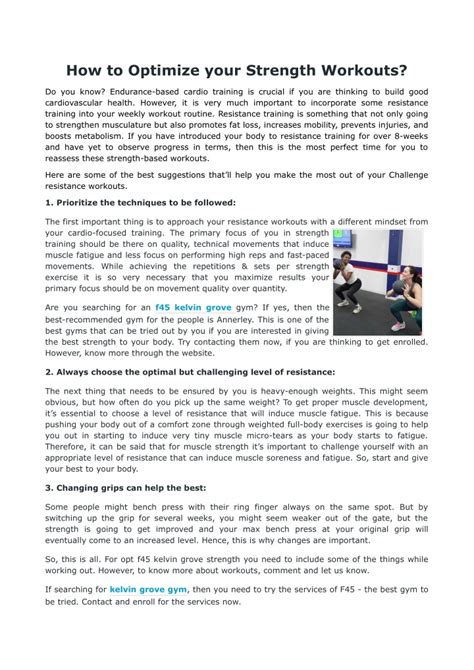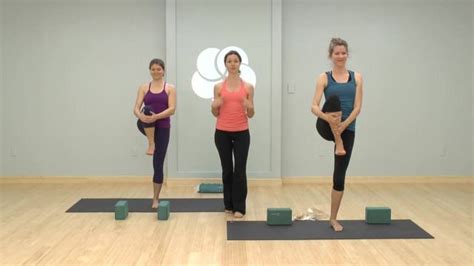How to optimize efficient 45-min workouts for peak strength, endurance, and faster recovery?

Unlock Your Potential with Power-Packed 45-Minute Workouts
In our fast-paced world, finding time for extensive workouts can be a significant challenge. However, a shorter duration doesn’t have to mean compromised results. With intelligent planning and execution, 45-minute workouts can be incredibly effective for building peak strength, enhancing endurance, and even accelerating recovery. The key lies in optimizing every minute, focusing on intensity, compound movements, and smart recovery protocols.
The Power of Precision: Why 45 Minutes?
Forty-five minutes is a sweet spot for many fitness enthusiasts. It’s long enough to achieve a substantial physiological stimulus but short enough to prevent burnout and excessive cortisol release associated with overly long sessions. This duration encourages focused intensity, making every set and rep count. It also makes adherence easier, fitting seamlessly into busy schedules without feeling like an overwhelming commitment.

Structuring Your 45-Minute Powerhouse Workout
To maximize efficiency, a well-structured workout is paramount. Every segment should serve a purpose, moving you closer to your strength, endurance, and recovery goals.
Warm-up (5-7 minutes): Dynamic Preparation
Begin with a dynamic warm-up to increase blood flow, mobilize joints, and prepare your nervous system. Include exercises like arm circles, leg swings, torso twists, and light cardio (e.g., jumping jacks, high knees). This reduces injury risk and optimizes performance for the main session.
Main Workout (30-35 minutes): Maximize Intensity
- Compound Movements First: Prioritize multi-joint exercises such as squats, deadlifts, overhead presses, bench presses, and rows. These engage more muscle groups simultaneously, eliciting a greater strength and muscle-building response in less time.
- Supersets & Circuits: Pair opposing muscle groups (e.g., chest press with bent-over rows) or non-competing exercises to minimize rest time and increase overall work capacity. Circuit training, moving from one exercise to the next with minimal rest, is excellent for boosting endurance and calorie expenditure.
- High-Intensity Interval Training (HIIT): Incorporate short bursts of maximum effort followed by brief recovery periods. This can be integrated with bodyweight exercises, cardio machines, or even resistance training for potent endurance and metabolic conditioning benefits.
- Progressive Overload: Crucial for continuous improvement. Aim to gradually increase the weight, reps, sets, or decrease rest periods over time. Your body adapts, so you must continually challenge it to grow stronger and build endurance.

Cool-down (5 minutes): Flexibility and Recovery
Conclude with static stretches, holding each stretch for 20-30 seconds. Focus on major muscle groups worked during the session. This helps improve flexibility, reduce muscle soreness, and signal to your body that it’s time to begin the recovery process.
Optimizing for Peak Strength and Endurance
Achieving both strength and endurance within 45 minutes requires smart programming and understanding training principles.
Strategic Exercise Selection
As mentioned, compound movements are kings for strength. For endurance, blend these with functional bodyweight exercises or short, intense cardio intervals. Alternate your focus across different training days – one day might lean more towards heavier strength work, another towards higher volume or metabolic conditioning.
Varying Intensity and Rep Ranges
For strength, aim for lower rep ranges (e.g., 3-6 reps) with heavier weights. For endurance, opt for higher rep ranges (e.g., 10-15 reps), longer time under tension, or extended work intervals in HIIT protocols. Cycling between these approaches ensures well-rounded development.
Periodization and Progressive Overload
Implement a form of periodization, even a simple one. For example, spend 3-4 weeks focusing more on strength, followed by 3-4 weeks emphasizing endurance. Regardless of the focus, always strive for progressive overload – whether it’s adding weight, doing more reps, increasing sets, or improving technique.

Accelerating Recovery for Continuous Gains
The workout is only half the battle. Your body adapts and grows stronger during recovery. Optimizing this phase is crucial for consistent progress and preventing overtraining.
Nutrition: Fueling and Repair
Post-Workout Nutrition: Consume a mix of protein and carbohydrates within an hour after your workout. Protein aids muscle repair and growth, while carbs replenish glycogen stores. Think chicken and rice, a protein shake with fruit, or Greek yogurt.
Overall Diet: Maintain a balanced diet rich in whole foods, lean proteins, healthy fats, and plenty of fruits and vegetables to supply essential vitamins and minerals for optimal recovery and performance.
Sleep: The Ultimate Performance Enhancer
Prioritize 7-9 hours of quality sleep per night. During deep sleep, your body releases growth hormone, which is vital for muscle repair and recovery. Lack of sleep can impair performance, increase injury risk, and hinder recovery.
Active Recovery and Mobility Work
On rest days, engage in light activities like walking, cycling, or swimming. Incorporate foam rolling and static stretching to improve blood flow, reduce muscle stiffness, and enhance range of motion. This aids in flushing out metabolic waste and preparing your muscles for the next session.

Sample 45-Minute Workout Blueprint (Full Body)
- Warm-up (7 min): Light cardio, dynamic stretches.
- Block 1 (15 min – Strength Focus):
- Barbell Squats (3 sets of 5-8 reps)
- Dumbbell Bench Press (3 sets of 8-12 reps)
- Bent-Over Rows (3 sets of 8-12 reps)
- Block 2 (15 min – Endurance/HIIT Circuit): Perform each exercise for 45 seconds, rest 15 seconds, move to the next. Complete 2-3 rounds.
- Burpees
- Kettlebell Swings
- Mountain Climbers
- Push-ups
- Cool-down (8 min): Static stretches focusing on quads, hamstrings, chest, and back.
Consistency and Listening to Your Body
Even the most perfectly optimized plan won’t yield results without consistency. Aim for 3-4 optimized 45-minute sessions per week, allowing for adequate rest. Equally important is listening to your body. If you feel overly fatigued or experience persistent pain, don’t hesitate to take an extra rest day or modify your workout. Overtraining can be as detrimental as undertraining.

Conclusion
Forty-five minutes is more than enough time to build a strong, resilient, and enduring physique. By focusing on high-intensity compound movements, strategic programming, and meticulous recovery, you can maximize every moment in the gym. Embrace the power of efficiency, commit to consistency, and watch your strength, endurance, and overall fitness soar.






